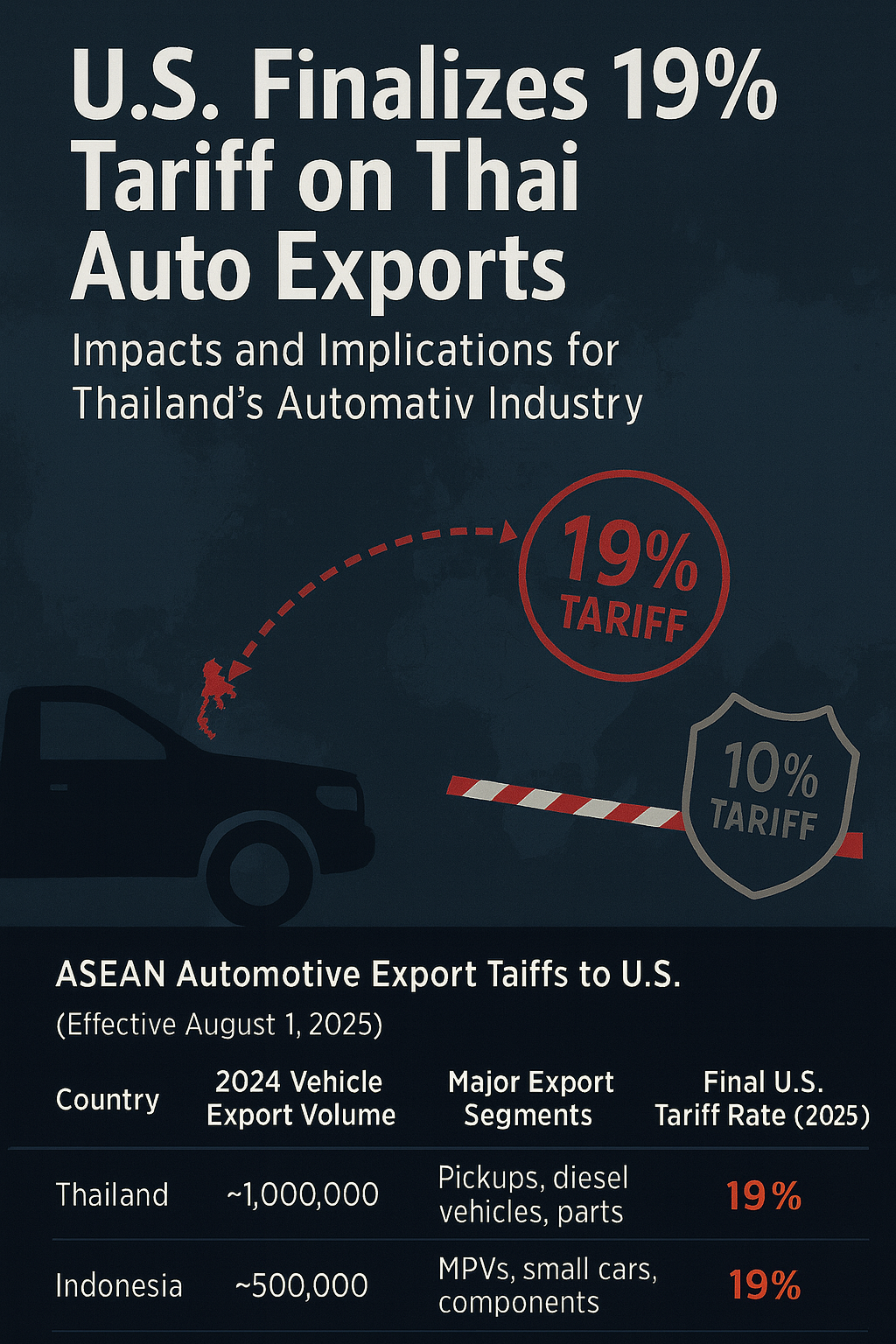
How ASEAN’s Leading Auto Exporters Are Adapting to America’s New Trade Rules
On July 31, 2025, the United States finalized a 19% import tariff on Thai goods—automobiles and components included—under the Trump administration’s “reciprocal tariff” initiative. This announcement brought relief to Thai exporters, who had faced the threat of a much steeper 36% duty.
However, Thailand wasn’t alone. Neighboring ASEAN auto-exporting nations—Indonesia and Vietnam—were also assigned nearly identical tariff rates, effectively reshaping the playing field for Southeast Asia’s automotive trade with the U.S.
ASEAN’s Automotive Exporters: All in the Same Boat?
While Thailand remains ASEAN’s largest vehicle exporter, both Indonesia and Vietnam have made significant strides in automotive manufacturing and exports in recent years:
- Thailand continues to dominate in pickups and commercial vehicles, with U.S. exports comprising a crucial segment—especially models derived from the Toyota Hilux and Ford Ranger platforms.
- Indonesia has grown as a hub for MPVs, small passenger cars, and components, with Japanese and Chinese OEMs leading the charge.
- Vietnam, though a smaller exporter by volume, has been making waves through VinFast’s expansion into EV markets in the U.S., Canada, and Europe.
With the new tariff rates now confirmed, all three nations face similar barriers to maintaining competitiveness in the U.S. market.
ASEAN Automotive Export Tariffs to the U.S. (Effective August 1, 2025)
| Country | 2024 Vehicle Export Volume | Major Export Segments | Final U.S. Tariff Rate (2025) |
|---|---|---|---|
| Thailand | ~1,000,000 units | Pickups, diesel vehicles, parts | 19% |
| Indonesia | ~500,000 units | MPVs, small cars, components | 19% |
| Vietnam | ~70,000 units (est.) | Electric vehicles (EVs) | 20% |
| Malaysia | ~30,000 units (limited exports) | CKD assembly, niche passenger cars | 0–5% (MFN rate, not targeted) |
| Philippines | Minimal | Primarily parts, limited CKD kits | 0–5% (MFN rate, not targeted) |
Sources: ASEAN Automotive Federation, Proliance analysis
What This Means for Thailand’s Automotive Sector
1. Margin Pressure
The 19% tariff raises the landed cost of Thai vehicles in the U.S., putting pressure on OEMs and suppliers to absorb costs or pass them on to consumers. This is especially challenging in the price-sensitive pickup segment.
2. U.S. Market Reassessment
OEMs may re-evaluate their U.S. export strategies, considering production diversification to tariff-exempt regions like Mexico (under USMCA) or shifting focus to less tariff-exposed markets like Australia and the Middle East.
3. Competitive Neutrality in ASEAN
While the tariff is a blow, the near-identical rates for Indonesia and Vietnam help maintain competitive neutrality within the region—no country gains a unilateral advantage.
4. Investor Caution and Repositioning
Foreign direct investment into Thailand’s automotive sector may decelerate, especially for projects aimed at the U.S. market. However, strong regional trade ties and ASEAN integration may offset this risk.
Strategic Implications for ASEAN as a Bloc
With three of ASEAN’s key auto-exporting nations grouped into the 19–20% U.S. tariff bracket, this marks a rare moment of equalized trade treatment. This could:
- Encourage regional collaboration on trade negotiations with the U.S.
- Stimulate intra-ASEAN supply chain realignment, especially for EVs and high-value components.
- Prompt joint advocacy through ASEAN mechanisms to revisit tariff terms post-2025 U.S. elections.
Final Thoughts
While the 19% tariff is a setback for Thailand and its neighbors, the uniformity of these measures ensures no ASEAN exporter is singled out. The road ahead will require agility, strategic planning, and closer intra-regional cooperation.
At Proliance, we’re committed to helping our clients track and interpret the impacts of these changes. With real-time access to vehicle registration and export flow data across ASEAN and the GCC, we help you stay ahead of the curve—tariff or not.


